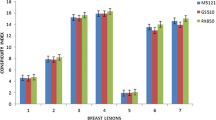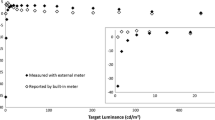Abstract
This article presents a review of image quality assessment methods for monochrome CRTs in the field as opposed to the laboratory. The review includes image quality programs at the University of Washington, the University of Texas at Houston, the University of Michigan, and the University of Arizona. CRT manufacturers and display-board suppliers also are concerned with image quality, particularly with respect to the life time of the CRT. The programs show that the need for image quality assessment for CRTs in the clinic is recognized. Although several experimental programs are in place, there is no universally accepted program. In fact, the clinical consequences of degraded monitor performance are not even well known and must be established. The existing programs mainly are based on the most comprehensive test pattern, the SMPTE pattern. The programs permit assessment of maximum luminance, display function, dynamic range, and contrast. They do not permit assessment of spatial resolution. There is no easy method to determine the spatial resolution in the field as precisely as desired simply because there are no visual aids (test patterns) to reliably determine loss of spatial resolution and signal-to-noise ratio using human observers. This report also presents initial and encouraging data obtained at the University of Arizona with a CCD camera. This CCD camera has the potential to be developed into an important tool for practical CRT evaluation for the clinic.
Similar content being viewed by others
References
Honeyman JC, Forst MM, Staab EV, et al: Prototype picture archiving and communication system in clinical neuroradiology. Program of the Annual Meeting of the RSNA, Chicago, IL, November 1990
Honeyman JC, Frost MM, Staab EV: Initial experiences with PACS in a clinical and research environment. SPE Medical Imaging V, San Jose, CA, February 1991
Capp MP, Roehrig H, Seeley GW: The Digital radiology department of the future. Radiol Clin North Am, 1985
Seeley GW, Ovitt TW, Capp MP: The total digital radiology department: An alternative view. AJR 144:421, 1985
Huang HK (moderator): Advances in medical imaging. Ann Intern Med 112:203–220, 1990
Goodman LR, Wilson CR, Foley WD: Digital radiography of the chest: Promises and problems. AJR 150:1241–1252, 1988
Chang J, Channin S, Przybylowicz J, et al: The Lightbox Part 1. RSNA Special Course in Computers in Radiology 1997, pp 61–70
Scott W, Bluemke D, Mysko W, et al: Interpretation of emergency department radiographs by radiologists and emergency medicine physicians: Teleradiology workstation versus radiographs readings. Radiology 195:223–229, 1995
Scott W, Rosenbaum J, Ackerman S, et al: Subtle Orthopedic Fractures: Teleradiology Workstation versus film interpretation. Radiology 187: 811–815, 1993
McLelland R, Hendrick RE, Zinninger MD, et al: The American College of Radiology Mammography Accreditation Program. AJR 157:473–479, 1991
American College of Radiology-Committee on Quality Assurance in Mammography, Mammography Quality Control-Medical Physicist's Manual, Appendix 2 (Measurement of viewbox luminance, illuminance and colortemperature). American College of Radiology. Reston, VA, 1992
Hendrick RE: Standardization of image quality and radiation dose in mammograph. Radiology 174:648–654, 1990
Blume H: The ACR-NEMA Proposal for a Gray-Scale Display Function Standard. Proc SPIE 2707:344–360, 1996
AAPM Task Force 18: Acceptance Testing and Quality Control of Electronic Display Devices for Soft-Copy Display of Medical Images, University of South Carolina, November 1998
Symer O, Orwin Associates: Personal communication, May 1994
Gray JE, Stears J, Wondrow M: Quality Control of Video Components and Display Devices. Proc SPIE 486:64–71, 1984
Gray JE, Lisk KG, Haddick DH, et al: Test pattern for video displays and hard-copy cameras. Radiology 154:519–527, 1985
Lisk KG: SMPTE test pattern for certification of medical diagnostic display devices. Proc SPIE 486:79–82, 1984
Parsons DM, Kim Y: Quality control assessment for the medical diagnostic imaging support (MDIS) system's display monitors. SPIE Medical Imaging 2164:186–197, 1994
Samei E, Flynn MJ: Acceptance testing of image display monitors. Henry Ford Health System, Detroit, MI; Personal communication, October 1998
Hemminger BM, Johnston RE, Rolland JP, et al: Perceptual linearization of video display monitors for medical image presentation. Proc SPIE 2164:222–241, 1994
Blume H, Roehrig H, Ji T-L: Very high resolution CRT display systems: Update on the state of the art of very high resolution monochrome CRT displays. SID 92 Digest 1992, pp 699–702
Blume H, Roehrig H, Ji T-L, et al: Very-high resolution monochrome CRT displays: How good are they really?. SID 91 Digest 1991, pp 355–358
Roehrig H, Blume H, Ji T-L, et al: Performance test and quality control of cathode ray tube displays. J Digit Imaging 3:134–145, 1990
Roehrig H, Blume H, Ji T-L, et al: Noise of CRT display systems. Proc SPIE 1897:232–245, 1993
Roehrig H, Dallas WJ, Ji T-L, et al: Physical evaluation of CRTs for use in digital radiography. Proc SPIE 1091:262–278, 1989
Roehrig H, Ji T-L, Browne M, et al: Signal-to-noise ratio and maximum information content of images displayed by a CRT. Proc SPIE. 1232:115–133, 1990
Przybylowicz J: Dome Imaging Systems; Personal communication, November 1997
Matthijs P: BARCO Display Systems; Personal communication, June 1999
Compton K: Clinton Electronics; Personal communication, May 1999
Volbrecht M: Image Systems Inc; Personal communication, May 1999
Eckhardt W, Siemens AG: Personal communication, May 1999
www.image-smiths.com
Van Metter R, Zhao BS, Kohm K: The sensitivity of visual targets for display quality assessment. Proc SPIE 3658: 254–268, 1999
Briggs SJ: Digital display test target development. Boeing Aerospace Co, Report No.D190-15960-1, 1977
Briggs SJ, Heagy D, Holmes R: Visual test target for display evaluation. SID 93 Digest 1993, pp 396–399
Briggs SJ: Manual: Digital test target BTP #4. Boeing Aerospace Co, Report No. DI 80 25066-1, 1979
SofTrack Version 3.0: A Quality Control System for Display Performance; National Information Display Laboratory, a Division of David Sarnoff Research Center Inc, Princeton, NJ
Hangiandreou NJ, Fetterly KA, Bernatz SN, et al: Quantitative evaluation of overall electronic display quality. J Digit Imaging 11:180–186, 1998
Author information
Authors and Affiliations
Additional information
Supported in part by a Grant from the Toshiba Corporation and NIH-SBIR Grant No. 1 R43 RR13524-01.
Rights and permissions
About this article
Cite this article
Roehrig, H., Willis, C.E. & Damento, M.A. Characterization of monochrome CRT display systems in the field. J Digit Imaging 12, 152–165 (1999). https://doi.org/10.1007/BF03168851
Issue Date:
DOI: https://doi.org/10.1007/BF03168851




